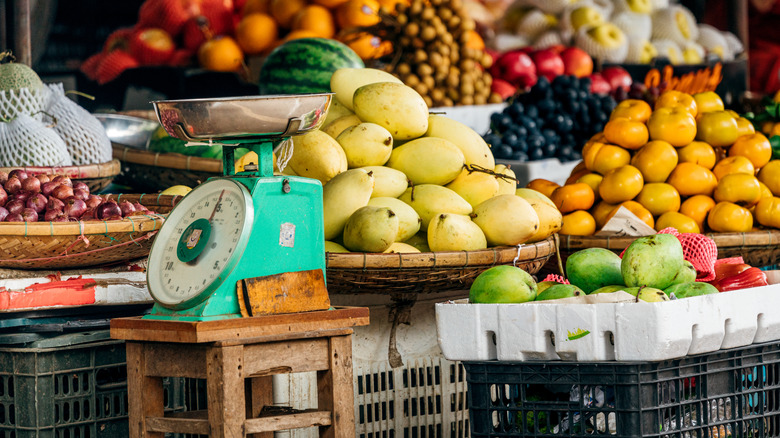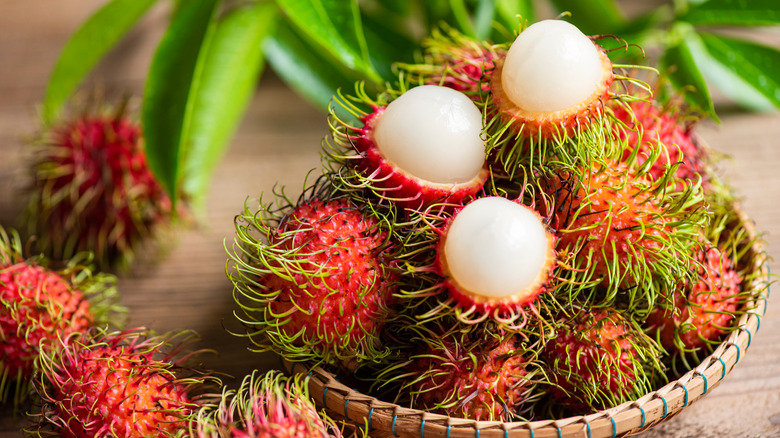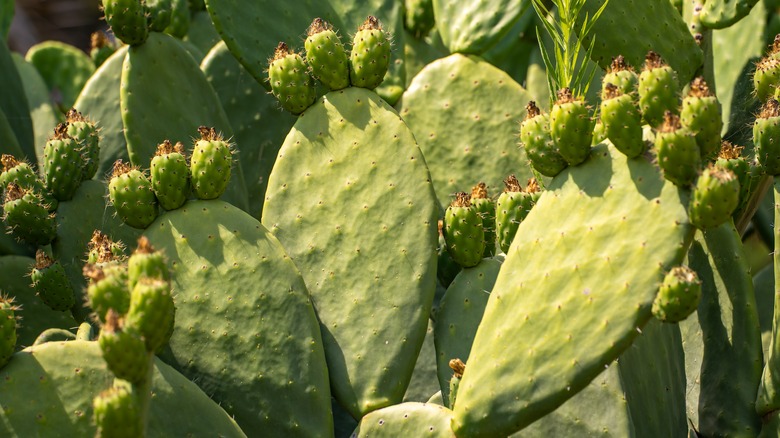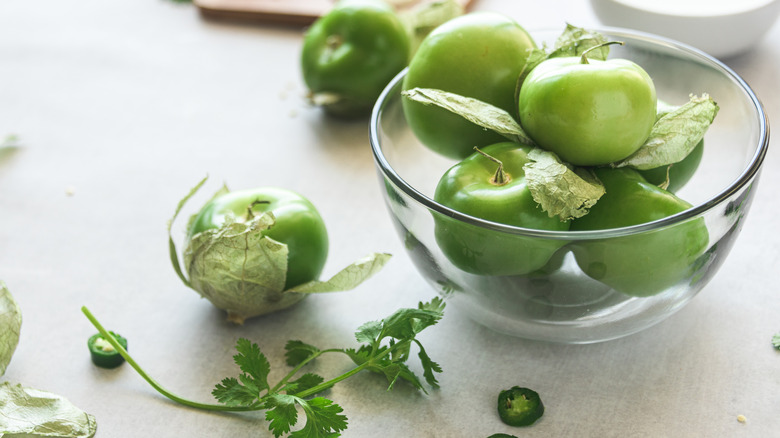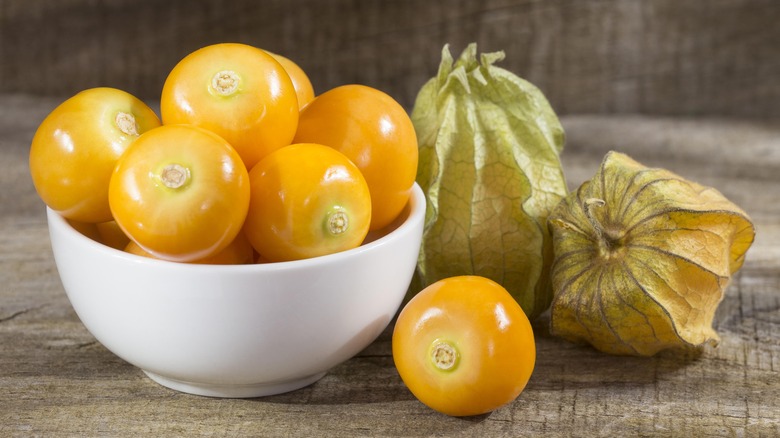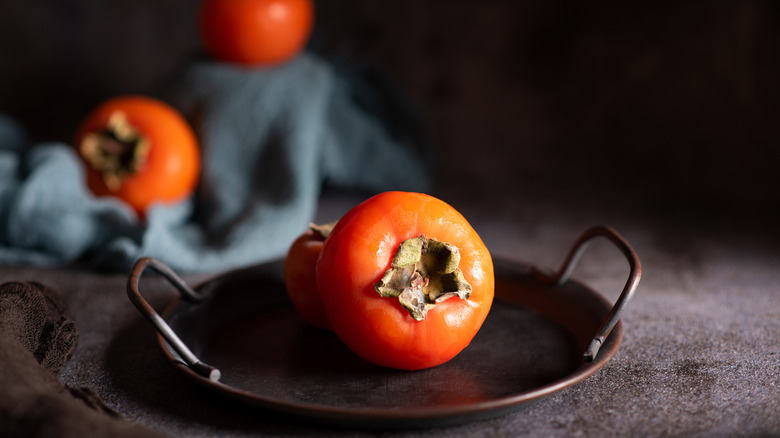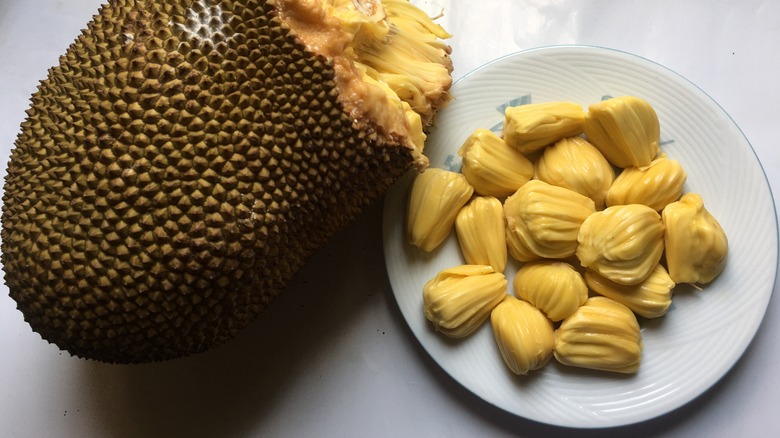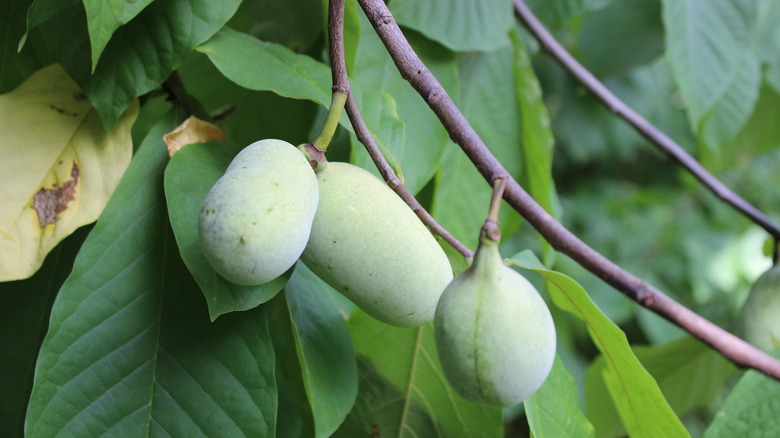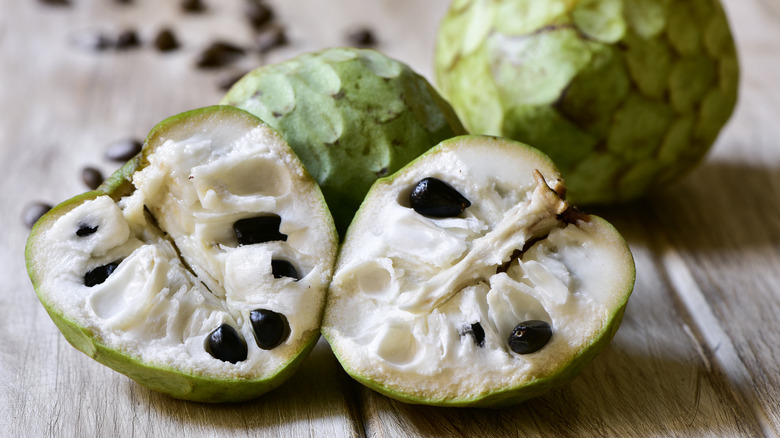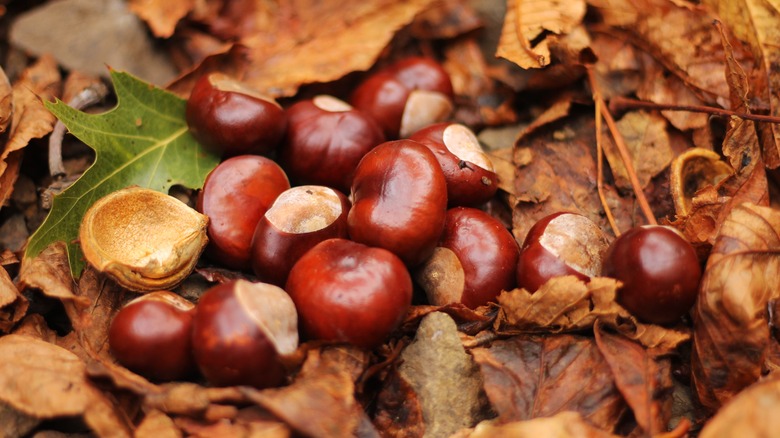9 Rare Farmer's Market Fruits And How To Eat Them
Mealy apples, tired grapes, and bruised bananas — these lunchbox staples are ever-present at the store and may have become part of your regular shopping routine. But supermarket produce can get old fast, especially when everything is trucked in from thousands of miles away. And the nutrition in fruit cultivated out of season (probably in a greenhouse somewhere on the other side of the country) is negligible at best.
But you don't have to settle for sub-par produce. Your local farmer's market is the perfect place to find delicious rare fruits grown in your region and harvested at the peak of flavor. For this reason, the farmer's market is also the best place to try out new flavors. You might be surprised how a new-to-you vegetable can perk up even your old standby recipes.
Because regional climates are so different, what's in season in your farmer's market won't be the same as a market across the country, but here are nine rare fruits to look for the next time you go shopping.
Rambutan
If you've ever seen a small fruit covered in spiky red hair at the farmer's market, chances are good you've already encountered rambutan. This prickly red fruit, appropriately named after the Malaysian word for hair (rambut) off-putting at first, is related to the lychee and is worth the effort it takes to prepare.
Rambutan is native to many regions in Asia but can be cultivated in United States with appropriate climates (i.e. California and Hawaii). The exterior spikes are soft, more hair than actual points, and the skin itself is leathery.
To eat rambutan fresh, peel off the outer covering to reveal the inner flesh. This resembles a peeled grape or a lychee fruit and tastes very similar. Rambutan has a pit, so be careful when eating fresh or chopping to put into recipes.
Many people prefer the sweet, tropical, almost-floral flavor and fragrance of the rambutan, but it can also be added to recipes. Rambutan is delicious as an addition to tropical fruit salad but can also be turned into ice cream, sorbet, and syrup for cocktails. Need an intriguing garnish that adds subtle flavor to a cocktail? Freeze peeled rambutan and add it as the finishing touch.
Nopales
When it comes to intimidating foods, nopales are right up there. This paddle of the prickly pear cactus is covered with tiny spikes sharp enough to pierce flesh. But the payout in the preparation is their unusual taste and meaty texture that is a staple in Mexican cuisine. Once cooked, this unusual farmer's market find can be added to various dishes to provide flavor and texture.
A delicious dish starts by picking the best nopales for the job. Look for bright green paddles that are not too firm but not floppy either. A bright color indicates freshness. Don't buy nopales that are squishy, limp, or dull. You can also eat the fruit of the prickly pear cactus (the tuna).
Gloves are a requirement to safely prepare nopales for cooking. Remove the bumps and spines of the cactus by running a sharp knife across its surface. You may need to cut off a few stragglers, but most spikes are easily removed by scraping. Rinse the nopales thoroughly, then dice or slice them before cooking in boiling salted water until tender. During cooking, nopales release slime, just like okra. Drain them when they are finished cooking, then give them a quick rinse before proceeding.
To prepare the prickly pear fruit, use tongs to burn the spikes off of the fruit. You can either peel the fruit (it's slippery so be careful), remove the seeds, and use it fresh, or freeze the fruit without peeling and then slide the skin off when you're ready.
Once cooked, add nopales to tacos, soups, salads, eggs, and fajitas. Nopales are perfect wherever you'd like a little extra texture and a slightly citrusy punch. Prickly pear can be eaten fresh out of hand or added to salads, cereals, smoothies, and desserts. Prickly pear juice is delicious on its own or as an addition to your favorite cocktails and mocktails.
Tomatillos
It sounds like a riddle: What looks like a green, paper-wrapped pumpkin but is usually the size of a golf ball and tastes like a lemon and a tomato had a baby? If you guessed tomatillos, you might be familiar with this indigenous Mexican fruit. Also known as a husk cherry or Mexican tomato, bright flavor is crammed into a tiny package that can elevate the simplest dishes.
Tomatillos (which can usually be found at a farmer's market) look like their cousins in the nightshade family — green tomatoes — but their flavor is entirely different. As tomatoes ripen and turn red, their flavors deepen and get sweet. But that's not the case with tomatillos. Even when ripe (and cooked), their citrusy brightness remains, perking up every other ingredient they touch.
Ripe tomatillos are green, yellow, or purple fruits surrounded by a husk that turns papery, tan, and brittle. They twist easily off the vine and may even fall off when perfectly ripe. Keep in mind that they will not continue to ripen after harvest. Picking tomatillos before they are ripe? Toss them in a sharp green salsa.
Pop whole tomatillos in an oven at 400 degrees Fahrenheit and roast them for 15 minutes or until their skin starts to shrivel and brown slightly. Let them cool, whip up your roasted tomatillo salsa, and start eating. Add salsa to huevos rancheros or enchiladas, or grab your favorite tortilla chips and start snacking.
Golden berries
Golden berries are an interesting fruit with a sweet-savory flavor that is versatile and fresh. Known also as Inca berries or cape gooseberries, these beautiful golden orbs are making waves in farmer's markets and grocery stores for their flavor, versatility, and nutritional benefits (via the Cleveland Clinic).
Originally grown in the Andes mountains and the Peruvian highlands, golden berries are a superfood chock full of antioxidants, vitamins, and anti-inflammatory compounds that boost health regardless of how they are prepared. They are cousins to tomatillos and share the same papery husk surrounding the marble-sized golden fruit.
Golden berries are ripe when their golden hue shines through a dried husk. They must be picked when ripe, as they do not continue to soften off the vine. Remarkably, they can be stored at room temperature for three months if left in their husk. Keep the fruits dry to prevent mold from forming.
Once harvested, their taste is similar in many ways to a sweet cherry tomato. In some cases, they also have a hint of tropical fruit that includes mango and pineapple. The versatile flavor of golden berries can go in either a savory or sweet direction. Pop the fresh fruit into your mouth for a satisfying snack, or chop them into salsa for tacos and chips. Add dried golden berries to trail mix, or make a bright, sweet jam that's perfect when swirled into yogurt or spooned onto toast.
Persimmon
Persimmons are the orange orbs of sweet, sticky fall flavors. In season from late fall to late winter, these beautiful globes can be a welcome addition to your dessert repertoire over the holidays.
There are two common types of persimmon: fuyu and hachiya. Both are syrupy and sweet when ripe, with notes of cinnamon and honey, but there are significant differences in appearance and use. Fuyu persimmons are orange and slightly squat, like a partially flattened pumpkin or tomato. They will turn deep orange and become somewhat soft when ripe. They can be eaten at varying stages of ripeness.
Hachiya persimmons are inedible unless completely ripe. Their shape is narrower, almost like a teardrop, with a more rounded top. Hachiya persimmons are left on trees to ripen until the inside is gelatinous, like pudding. Anything other than gentle handling at this stage will punch holes in the delicate skin, letting gelatinous syrupy fruit gush out. As the fruit ripens, the flavor deepens, with apricot notes.
Because persimmons are so finicky and easily damaged when ripe, the farmer's market is often the only place to find them (or a backyard tree). Hachiya persimmons dry exceptionally well into a chewy snack with minimal preparation. Persimmons can also be cooked and used to make pudding, jam, and bread, or blended with sugar and water to make persimmon simple syrup for cocktails.
Jackfruit
The largest tropical fruit in the world is also one of the most versatile, pulling its weight in sweet and savory dishes. When spotted in the local farmer's market, the jackfruit's size and unassuming exterior might cause some shoppers to walk on by. But look closer: Its nubby exterior is the perfect staple ingredient, an affordable fruit dubbed "the poor man's fruit" for its abundance and nutritional value (per Medical News Today).
Jackfruit in the wild weighs up to 100 pounds, but it will be closer to between 10 and 25 pounds at the farmer's market. It is related to figs and mulberries and can be cultivated in warmer states such as Hawaii and California. The outside of this fruit ranges in shape from round to oval — and it's nubbed, with a bright green exterior when unripe and a dull greenish-brown when fully ripe. Which you choose depends on how you'd like to use it. Unripe jackfruit is the undisputed star of vegetarian barbecue dishes, with a texture closely resembling pulled pork. Looking for a sweet, tropical addition for dessert? You'll want the jackfruit to be very ripe for the best flavor.
You'll want to wash fresh jackfruit. Then use a chef's knife coated with coconut oil to cut off both ends and cut down through the middle. This prevents the blade from getting bogged down in the sticky flesh. Cut each half into quarters, then cut out the core. Peel each aril — the edible seed pod of the fruit — away from the inner fibers. You can remove the seed from the aril (roast it later and use it in curry or other Indian dishes) and use the aril in your dish.
Pawpaw
The pawpaw (the largest indigenous fruit in North America) is available along rivers, in wet bottomlands, and at your local farmer's market from late summer to September or October (depending on your local climate). As a tropical fruit, pawpaws are unique in that they can thrive in a temperate climate. They grow wild and natively in 26 states, from the Great Lakes to Florida to Medford, Oregon.
Move fast when you see these in the farmer's market. They range in size from 2 to 4 inches and are shaped like an elongated mango (or a large kidney bean). Their skins can be bright green, gold, and anywhere in between. Inside, pawpaws have a velvety texture broken up by giant seeds. Much like the mango, it can be challenging to remove the flesh from the seeds, but the seeds are inedible and should be discarded.
The pawpaw flavor varies wildly from species to species. Some taste almost cloyingly sweetly of bubblegum. Others more closely resemble the flavor profile of a banana, a slightly underripe pineapple, papaya, or any combination of those tropical fruits.
Be warned: Your pawpaws need to be completely ripe before you eat them. When unripe, their flesh is highly astringent and will wipe every bit of moisture out of your mouth. Once they ripen, the clock is ticking, as their shelf life is about 24 hours from just ripe to rotten.
Pawpaws are best eaten raw, but their mild flavor also works well in delicate dessert preparations such as puddings, ice cream, and delicate fillings for pastry.
Cherimoya
Literary lion Mark Twain called the cherimoya "the most delicious fruit known to man." With a recommendation like that, it might be time to try this culinary gem when it pops up at your local farmer's market. Cherimoya is native to the Andes but has been cultivated all across the globe as its popularity rises.
Also referred to as a custard apple — a misnomer, as the custard apple is something entirely different — cherimoya is more closely related to sweetsop and soursop fruits. It's approximately the size of a softball (although it can reach a weight of up to 11 pounds) and looks like it's covered in green triangular scales that resemble an artichoke's leaves. Cut it open to reveal a creamy interior with large, dark-brown seeds. These seeds are toxic if crushed, so set them aside and get ready to sample the flesh of the cherimoya.
The predominant flavor of the cherimoya is straight-up candy with a sweet, silky mouthfeel. Some compare it to extra-ripe pineapple or papaya, while others think it tastes like bubblegum or strawberry. Slight variations in flavor are possible due to different varieties or growing regions. Still, many tasters agree it is one of the most delicious fruits available at a farmer's market.
Ripen a hard cherimoya at room temperature, waiting for the skin to depress slightly (like you'd ripen an avocado), then open it and scoop the sweet flesh out with a spoon to eat raw. Cherimoya also makes a great addition to a smoothie, salsa, and tropical fruit salad.
Winter bonus: chestnuts
If you've any holiday spirit whatsoever, you're familiar with chestnuts roasting on an open fire. If you're also lucky enough to live in an area with a fall or winter farmer's market, chances are good they stock fresh chestnuts from the end of September to January. Bitter when raw, these dark brown nuts soften and sweeten when kissed with indirect heat and become a beautiful staple ingredient at the holiday table in stuffings, salads, cakes, and on their own with full-bodied red wine. When selecting chestnuts, look for round, glossy nuts that have tight brown skin and feel heavy for their size.
The simplest preparation is roasting. This brings out the chestnut's rich, sweet flavor, and the resulting nut meat can be either eaten directly out of the oven or reserved for other uses. While roasting in a backyard fire pit or over hot coals is traditional (and ideal), an oven at 425 degrees Fahrenheit works, too.
Preheat your oven — place a baking rack over a sheet pan. Cut a shallow "X" into the round end of each chestnut. This prevents them from exploding (as they roast) when steam builds up and makes them easier to peel. Place them on the rack and then into the oven for 15 to 20 minutes. The nut meat should get soft, and the skins will peel back.
Remove from the oven, then place in a towel and carefully give them a squeeze (they will crackle in response). Let them sit for five minutes, then peel carefully, removing the hard outer shell and papery skin to reveal smooth, off-white nut meat. Enjoy as is, or grind into a smooth paste with vanilla, sugar, and water to make marron glacés, a sweet spread that is delicious on its own or in recipes for salads and desserts.

